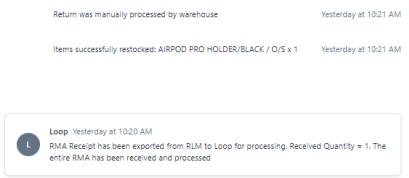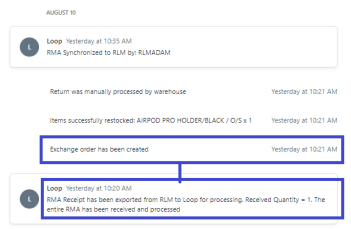RLM Integration
OVERVIEW
The integration between RLM Apparel Software and Loop is a two-way integration, responsible for performing two primary actions:
Create RMAs within RLM when a return is initiated in Loop
Process or flag a return within Loop based on items received by RLM
This integration is owned and maintained by RLM.
Important: This article reviews the setup of the newest version of the RLM x Loop integration. If you are currently using the previous version of this integration, please be aware that Loop will not be making any improvements or updates to that version and support will be limited. If you're not sure what version of the integration you're using, please contact your Merchant Success Manager.
How it works
This integration imports RMAs from Loop Returns into RLM each time a return is initiated and takes action within Loop (process or flag) upon item receipt by RLM.
Standard Returns Flow
Customer initiates a Loop Return, generating an RMA in Loop.
The RLM scheduled job ‘LoopImportReturnAuthorizations’ pulls the RMA from Loop, and creates an RA within RLM. This will be shown on the Return History in Loop Admin site, shown below.
RLM transmits the RA/ASN to the 3PL, via the 3PL integration.
The warehouse receives the return against the RA.
The warehouse transmits the receiving to RLM, via the 3PL integration.
The RLM scheduled job ‘LoopExportReturnReceipts’ exports the receiving to Loop.
In Loop, the RMA is processed. In Shopify, items will be marked returned and restocked. This will be shown on the Return History in Loop Admin, shown below.
RLM runs the ‘ShopifyImportRefunds’ job.
Inventory is restocked on RLM.
The invoice for the returned goods is generated.
The update to inventory on RLM is included in the next run of the export of inventory from RLM to Shopify.
Exchange Flow for Item of Same Value
This flow is the same as the standard returns flow above until step 8.
Customer initiates a Loop Return, generating an RMA in Loop.
The RLM scheduled job ‘LoopImportReturnAuthorizations’ pulls the RMA from Loop and creates an RA within RLM.
RLM transmits the RA/ASN to the 3PL via 3PL integration.
The warehouse receives the return against the RA.
The warehouse transmits the receiving to RLM, via the 3PL integration.
The RLM scheduled job ‘LoopExportReturnReceipts’ exports the receiving to Loop.
In Loop, the RMA is processed. This will initiate a refund in Shopify to the customer and it will also restock the inventory on Shopify.
Once the RMA has been fully processed in Loop, the exchange order will be created in Shopify.
For the original order, steps 10 and 11 will continue as normal.
RLM runs the ‘ShopifyImportRefunds’ job.
Inventory is restocked on RLM.
The invoice for the returned goods is generated.
The update to inventory on RLM is included in the next run of the export of inventory from RLM to Shopify.
RLM will import the exchange order, during the next run of RLM’s Shopify Import Orders scheduled job.
The exchange order will come into RLM with the merchandise value and will be offset by a misc. charge to = a $0 A/R value on the exchange order.
Note: If the Loop-discount is set to ON, the offsetting value will appear as a DISCOUNT on the order instead.
The exchange order will flow through RLM like a regular order.
Damaged Items Flow
This flow is the same as the standard returns flow above until step 8.
Customer initiates a Loop Return, generating an RMA in Loop.
The RLM scheduled job ‘LoopImportReturnAuthorizations’ pulls the RMA from Loop and creates an RA within RLM.
RLM transmits the RA/ASN to the 3PL via 3PL integration.
The warehouse receives the return against the RA and finds that the item is damaged.
The receiving is marked as second quality and transmitted to RLM.
The RLM scheduled job ‘LoopExportReturnReceipts’ exports the receiving to Loop, but flags that it will require manual review within the Loop Admin.
A team member will need to review and process the return. In most cases, the team will not want the item to be restocked as available to sell in Shopify and RLM and will uncheck the item as below.
Loop will transmit the refund to Shopify, but indicates NO_RESTOCK.
RLM runs the ‘ShopifyImportRefunds’ job.
Using the NO_RESTOCK information received from Shopify, RLM will use the second quality warehouse assigned to the original warehouse on the received RA to restock the unit.
This will allow the unit to come into stock against an RLM damages warehouse, rather than being added to sellable inventory.
The invoice for the returned goods is generated.
Items Missing from Return Flow (RA with a Short Receiving)
This flow is the same as the standard returns flow above until step 4.
Customer initiates a Loop Return, generating an RMA in Loop.
The RLM scheduled job ‘LoopImportReturnAuthorizations’ pulls the RMA from Loop and creates an RA within RLM.
RLM transmits the RA/ASN to the 3PL via 3PL integration.
The warehouse short receives the return against the RA.
The warehouse transmits the receiving to RLM, via the 3PL integration.
The RLM scheduled job ‘LoopExportReturnReceipts’ exports the receiving to Loop – this short receiving will be flagged for review in the Loop Admin portal.
A team member will need to review and reject/process the return. If the receiving was missing only partial lines from the order, those missing lines can be removed within the Loop Admin so that the rest of the return can be processed as normal.
FAQ
What happens to an order that is refunded in Shopify, that never shipped from RLM? If an order (or a line on the original order) was not shipped from RLM, the Shopify refund will not import to RLM. This is because the item never left RLM inventory so it cannot be added back via a credit.
What does ‘Refund ID Already Exists’ mean in the Shopify Refunds screen in RLM? While this is kept in the Error Message column, it is NOT an error. The Shopify Import Refunds job will check against existing refunds for further updates. If the refund ID already exists in RLM, there is no further action to take so it will display this message.
What plan do I need to be on to utilize this feature? This feature is included for merchants with Loop Plus or the Integrations add on. If you are not on one of these plans and would like to add this feature reach out to your Merchant Success Manager or support@loopreturns.com.
How long will it take to set up this integration? Implementation and maintenance is handled by Loop, with collaboration from RLM. The timeline is approximately 2-4 weeks from kickoff with Loop.
Will I need a developer involved to complete this integration? Not at all! Loop & RLM will take care of this integration for you.
How do I get started? To begin the integration process, please create a case via RLM's portal at Aptean Connect.
Please contact RLM Support at Aptean Connect for any additional questions on this integration.



